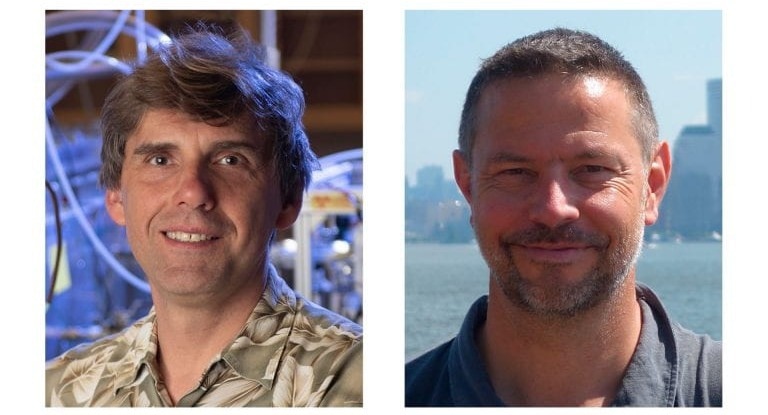Numerous pollutants are emitted into the atmosphere as a result of human activities, and without a molecule called hydroxide (OH), many of these pollutants would continue to aggregate in the atmosphere.

Sergey Nizkorodov, UCI professor of Chemistry (left), and atmospheric chemist Christian George of the National Center for Scientific Research at the University of Lyon, France, led a project to derive a new understanding of how hydroxide molecules help clear the atmosphere of human-emitted pollutants and greenhouse gases. Image Credit: University of California, Irvine.
A strong electric field that persists at the surface between airborne water droplets and the surrounding air can generate OH by a completely undiscovered mechanism, according to new research published in Proceedings of the National Academy of Sciences by a research team led by Sergey Nizkorodov, a University of California, Irvine Professor of Chemistry.
This finding could change how scientists understand how the air clears itself from human-emitted pollutants and greenhouse gases, which OH can react with and eliminate.
You need OH to oxidize hydrocarbons, otherwise they would build up in the atmosphere indefinitely.
Sergey Nizkorodov, Professor, Chemistry, University of California, Irvine
OH is a key player in the story of atmospheric chemistry. It initiates the reactions that break down airborne pollutants and helps to remove noxious chemicals such as sulfur dioxide and nitric oxide, which are poisonous gases, from the atmosphere. Thus, having a full understanding of its sources and sinks is key to understanding and mitigating air pollution.
Christian George, Study Lead Author and Atmospheric Chemist, University of Lyon
Previously, experts considered that sunlight was the primary cause of OH formation.
The conventional wisdom is that you have to make OH by photochemistry or redox chemistry. You have to have sunlight or metals acting as catalysts. What this paper says in essence is you don’t need any of this. In the pure water itself, OH can be created spontaneously by the special conditions on the surface of the droplets.
Sergey Nizkorodov, Professor, Chemistry, University of California, Irvine
The study has been based on the work of Stanford University scientists led by Richard Zare, who discovered the spontaneous creation of hydrogen peroxide on the surfaces of water droplets. The new discoveries help to explain the Zare group’s unexpected results.
The team measured OH concentrations in different vials – some containing an air-water surface and others containing only water without any air – and tracked OH production in darkness by including a “probe” molecule in the vials that fluoresces when it reacts with OH.
They discovered that OH production rates in darkness mimic and even exceed rates from triggers such as sunlight exposure.
“Enough of OH will be created to compete with other known OH sources. At night, when there is no photochemistry, OH is still produced and it is produced at a higher rate than would otherwise happen,” adds Nizkorodov.
According to Nizkorodov, the findings modify understanding of the sources of OH, which will affect how other researchers create computer models that attempt to foresee how air pollution occurs.
“It could change air pollution models quite significantly. OH is an important oxidant inside water droplets and the main assumption in the models is that OH comes from the air, it’s not produced in the droplet directly,” notes Nizkorodov.
Nizkorodov believes that the next step is to conduct carefully designed experiments in the real environment in various parts of the world to evaluate whether this new OH generation process plays a role.
But first, the team expects the findings to make an immediate impact on the atmospheric research community.
“A lot of people will read this but will not initially believe it and will either try to reproduce it or try to do experiments to prove it wrong. There will be many lab experiments following up on this for sure,” concludes Nizkorodov.
He stated that UCI is an ideal place for such research to continue because other laboratories at UCI, such as Ann Marie Carlton’s, Professor of Chemistry, focus on the role of water droplets in the atmosphere.
The study was supported by the European Research Council. The research involved scientists from France’s University Claude Bernard, China’s Guangdong University of Technology, and Israel’s Weizmann Institute.
Journal Reference:
Li, K., et al. (2023). Spontaneous dark formation of OH radicals at the interface of aqueous atmospheric droplets. Proceedings of the National Academy of Sciences. doi.org/10.1073/pnas.2220228120.